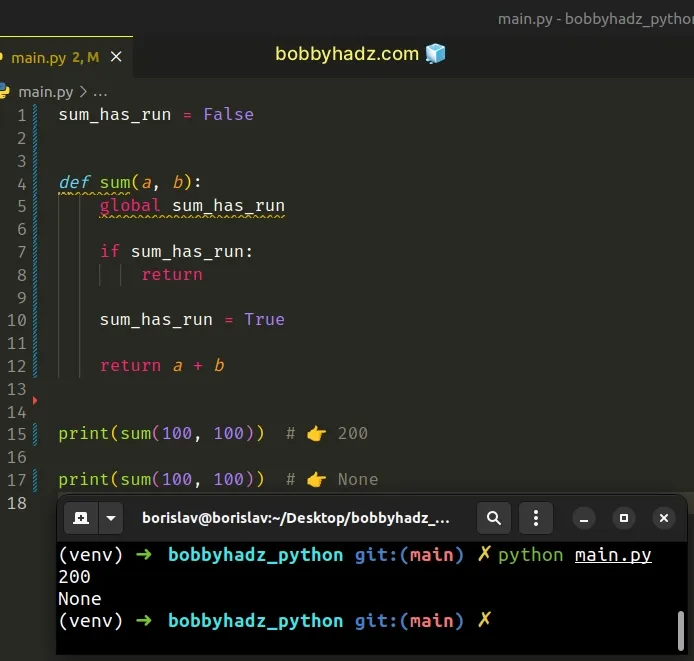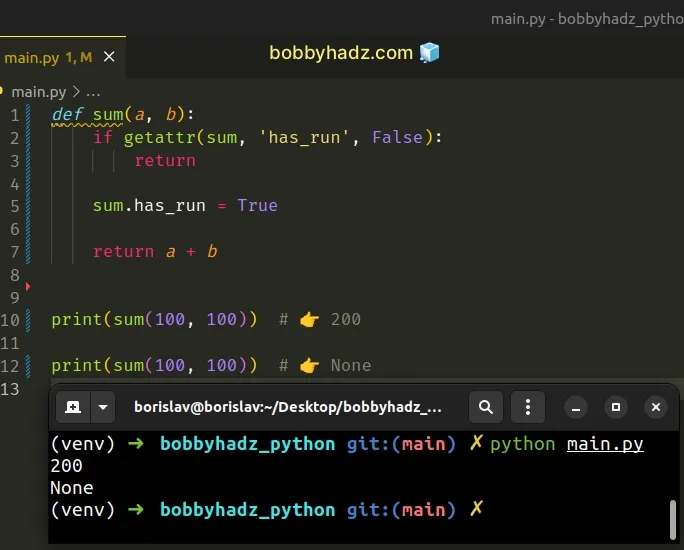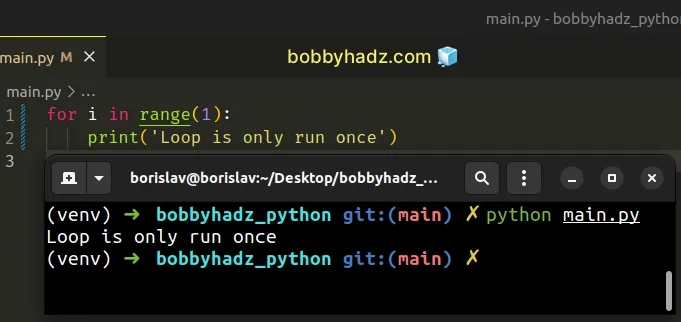Run a Function or a Loop only Once in Python
Last updated: Apr 9, 2024
Reading time·4 min

# Table of Contents
- Run a Function only Once in Python
- Run a Function only Once using an attribute
- Run a Loop only Once in Python
- Run a Loop only Once using a while True loop
- Run a Loop only Once using a break statement
- Run a Loop only Once using a boolean variable
# Run a Function only Once in Python
To run a function only once:
- Declare a global variable and initialize it to
False. - Change the value of the global variable to
Truein the function. - Only run the code in the function if the global variable is set to
False.
sum_has_run = False def sum(a, b): global sum_has_run if sum_has_run: return sum_has_run = True return a + b print(sum(100, 100)) # 👉️ 200 print(sum(100, 100)) # 👉️ None

The first example uses a global variable to run a function only once.
False and set its value to True in the function.If the value of the global variable is equal to True, we return from the
function straight away.
sum_has_run = False def sum(a, b): global sum_has_run if sum_has_run: return sum_has_run = True return a + b print(sum(100, 100)) # 👉️ 200 print(sum(100, 100)) # 👉️ None
True, we set its value to True and run the function.This only happens the first time the function is invoked.
Once the global variable is set to True, the function
returns None without running any code.
An alternative approach is to use an attribute on the function.
# Run a Function only Once using an attribute
This is a three-step process:
- Set a
has_runattribute on the function toTruethe first time it runs. - Each time the function is called, check if the
has_runattribute isTrueand return straight away. - The code in the function will only run the first time.
def sum(a, b): if getattr(sum, 'has_run', False): return sum.has_run = True return a + b print(sum(100, 100)) # 👉️ 200 print(sum(100, 100)) # 👉️ None

We set the has_run attribute to True the first time the function is called.
The getattr function returns the value of the provided attribute of the object.
The function takes the object, the name of the attribute and a default value for when the attribute doesn't exist on the object as parameters.
If the has_run attribute is not set on the function, we return a default value
of False.
has_run attribute each time the function runs and if its value is set to True, we return from the function straight away.If the has_run attribute is not set, the code in the function runs and sets
the attribute to True.
The code in the function is only run once.
# Run a Loop only Once in Python
You can run a loop only once by using the range() class with a stop value of
1.
for i in range(1): print('Loop is only run once')

The range() class is commonly used for looping
a specific number of times in for loops and takes the following arguments:
| Name | Description |
|---|---|
start | An integer representing the start of the range (defaults to 0) |
stop | Go up to, but not including the provided integer |
step | Range will consist of every N numbers from start to stop (defaults to 1) |
If you only pass a single argument to the range() constructor, it is
considered to be the value for the stop parameter.
for n in range(1): print(n) # 👉️ 0 result = list(range(1)) # 👇️ [0] print(result)
The for loop in the example only runs once.
# Run a Loop only Once using a while True loop
You can also use a while True loop to only run a loop once.
while True: print('Loop is only run once') break

A while True loop can only be stopped by using the break statement.
The break statement breaks out of the
innermost enclosing for or while loop.
# Run a Loop only Once using a break statement
You can also use the break statement to run a loop only once when iterating
over a sequence.
a_list = ['bobby', 'hadz', 'com'] for item in a_list: print(item) # 👉️ bobby break

The loop only prints the first item of the list and exits.
# Run a Loop only Once using a boolean variable
You can also use a boolean variable to run a loop only once.
a_list = ['bobby', 'hadz', 'com'] has_run = False for item in a_list: if has_run: break has_run = True print(item) # 👉️ bobby

We initialized the has_run variable to False.
The first time the for loop runs, we set the variable to True.
The next time the loop runs, the if condition is met and we exit out of the
loop.
I've also written an article on how to call a function N times.
If you need to call a function by a string name, click on the link and follow the instructions.
# Additional Resources
You can learn more about the related topics by checking out the following tutorials:
- How to check if a variable is a Function in Python
- How to Print the output of a Function in Python
- Why does my function print None in Python [Solved]
- Get all arguments passed to a Function in Python
- Get access to the Index in the map() function in Python
- Pass multiple arguments to the map() function in Python
- How to use a Variable from another Function in Python
- Python: Process finished with exit code 137 in PyCharm
- How to use Function Pointers in Python

